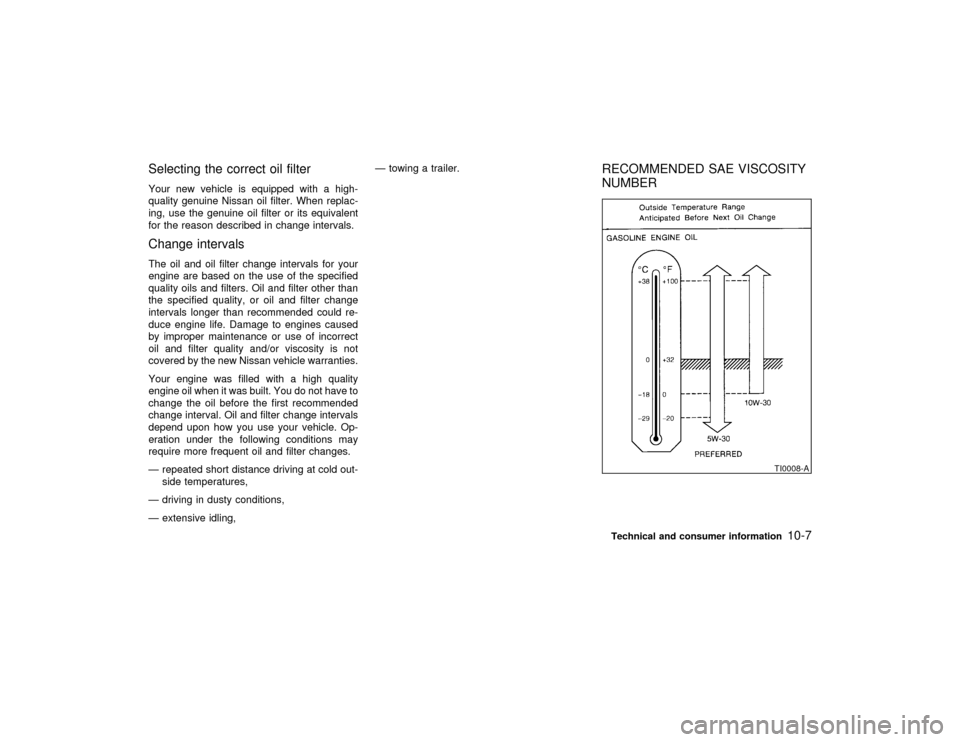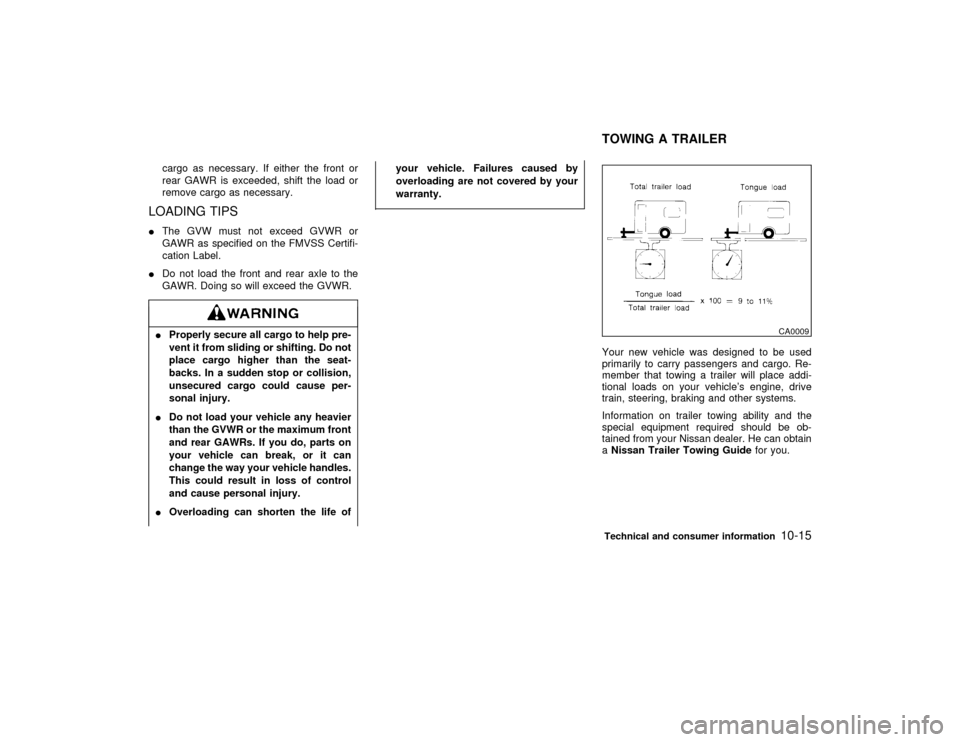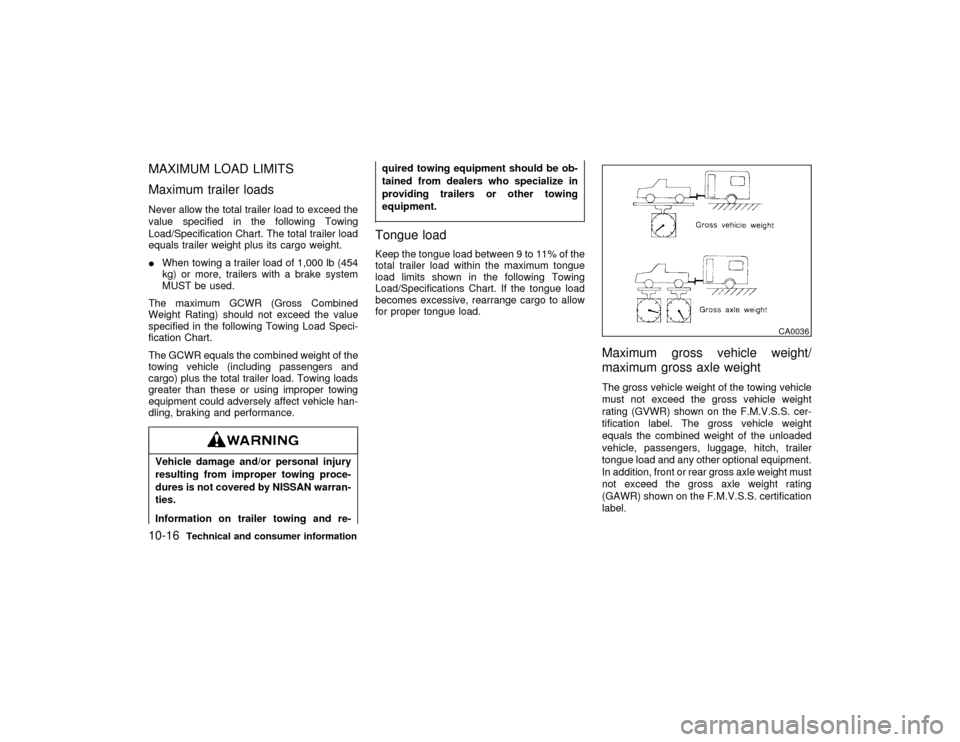1998 NISSAN PATHFINDER tow
[x] Cancel search: towPage 223 of 249

FUEL RECOMMENDATIONYour vehicle is designed to operate on
unleaded gasoline with an octane rating of
at least 87 AKI (Anti-Knock Index) number
(Research octane number 91).Using a fuel other than that specified
could adversely affect the emission con-
trol devices and systems, and could
also affect the warranty coverage.
Under no circumstances should a
leaded gasoline be used since this will
damage the three way catalyst.Reformulated gasolineSome fuel suppliers are now producing refor-
mulated gasolines. These gasolines are spe-
cially designed to reduce vehicle emissions.
NISSAN supports efforts towards cleaner air
and suggest that you use reformulated gaso-
line when available.Gasoline containing oxygenatesSome fuel suppliers sell gasoline containing
oxygenates such as ethanol, MTBE andmethanol with or without advertising their pres-
ence. Nissan does not recommend the use of
fuels of which the oxygenate content and the
fuel compatibility for your Nissan cannot be
readily determined.
If you use oxygenate-blend gasoline, please
take the following precautions as the usage of
such fuels may cause vehicle performance
problems and/or fuel system damage.
IThe fuel should be unleaded and have
an octane rating no lower than that rec-
ommended for unleaded gasoline.
IIf an oxygenate-blend, excepting a
methanol blend, is used, it should con-
tain no more than 10% oxygenate.
(MTBE may, however, be added up to
15%.)
IIf a methanol blend is used, it should
contain no more than 5% methanol (me-
thyl alcohol, wood alcohol). It should
also contain a suitable amount of appro-
priate cosolvents and corrosion inhibi-
tors. If not properly formulated with ap-
propriate cosolvents and corrosion
inhibitors, such methanol blends may
cause fuel system damage and/or ve-
hicle performance problems. At this
time, sufficient data is not available to
ensure that all methanol blends are suit-able for use in Nissan vehicles.
If any undesirable driveability problems such
as engine stalling and hard hot starting are
experienced after using oxygenate-blend fu-
els, immediately change to a non-oxygenate
fuel or a fuel with a low blend of MTBE.
Take care not to spill gasoline during refu-
eling. Gasoline containing oxygenates can
cause paint damage.
After market fuel additivesNISSAN does not recommend the use of any
fuel additives (i.e.: fuel injector cleaner, octane
booster, intake valve deposit removers, etc.)
which are sold commercially. Many of these
additives intended for gum, varnish or deposit
removal may contain active solvents or similar
ingredients that can be harmful to the fuel
system and engine.Octane rating tipsIn most parts of North America, you should use
unleaded gasoline with an octane rating of at
least 87 AKI (Anti-Knock Index) number. How-
ever, you may use unleaded gasoline with an
octane rating as low as 85 AKI (Anti-Knock
Index) number in these high altitude areas
[over 4,000 ft (1,219 m)] such as: Colorado,
Montana, New Mexico, Utah, Wyoming, north-
10-4
Technical and consumer information
Z
01.1.31/R50-D
X
Page 226 of 249

Selecting the correct oil filterYour new vehicle is equipped with a high-
quality genuine Nissan oil filter. When replac-
ing, use the genuine oil filter or its equivalent
for the reason described in change intervals.Change intervalsThe oil and oil filter change intervals for your
engine are based on the use of the specified
quality oils and filters. Oil and filter other than
the specified quality, or oil and filter change
intervals longer than recommended could re-
duce engine life. Damage to engines caused
by improper maintenance or use of incorrect
oil and filter quality and/or viscosity is not
covered by the new Nissan vehicle warranties.
Your engine was filled with a high quality
engine oil when it was built. You do not have to
change the oil before the first recommended
change interval. Oil and filter change intervals
depend upon how you use your vehicle. Op-
eration under the following conditions may
require more frequent oil and filter changes.
Ð repeated short distance driving at cold out-
side temperatures,
Ð driving in dusty conditions,
Ð extensive idling,Ð towing a trailer.
RECOMMENDED SAE VISCOSITY
NUMBER
TI0008-A
Technical and consumer information
10-7
Z
01.1.31/R50-D
X
Page 234 of 249

cargo as necessary. If either the front or
rear GAWR is exceeded, shift the load or
remove cargo as necessary.
LOADING TIPSIThe GVW must not exceed GVWR or
GAWR as specified on the FMVSS Certifi-
cation Label.
IDo not load the front and rear axle to the
GAWR. Doing so will exceed the GVWR.IProperly secure all cargo to help pre-
vent it from sliding or shifting. Do not
place cargo higher than the seat-
backs. In a sudden stop or collision,
unsecured cargo could cause per-
sonal injury.
IDo not load your vehicle any heavier
than the GVWR or the maximum front
and rear GAWRs. If you do, parts on
your vehicle can break, or it can
change the way your vehicle handles.
This could result in loss of control
and cause personal injury.
IOverloading can shorten the life ofyour vehicle. Failures caused by
overloading are not covered by your
warranty.
Your new vehicle was designed to be used
primarily to carry passengers and cargo. Re-
member that towing a trailer will place addi-
tional loads on your vehicle's engine, drive
train, steering, braking and other systems.
Information on trailer towing ability and the
special equipment required should be ob-
tained from your Nissan dealer. He can obtain
aNissan Trailer Towing Guidefor you.
CA0009
TOWING A TRAILERTechnical and consumer information
10-15
Z
01.1.31/R50-D
X
Page 235 of 249

MAXIMUM LOAD LIMITS
Maximum trailer loadsNever allow the total trailer load to exceed the
value specified in the following Towing
Load/Specification Chart. The total trailer load
equals trailer weight plus its cargo weight.
IWhen towing a trailer load of 1,000 lb (454
kg) or more, trailers with a brake system
MUST be used.
The maximum GCWR (Gross Combined
Weight Rating) should not exceed the value
specified in the following Towing Load Speci-
fication Chart.
The GCWR equals the combined weight of the
towing vehicle (including passengers and
cargo) plus the total trailer load. Towing loads
greater than these or using improper towing
equipment could adversely affect vehicle han-
dling, braking and performance.Vehicle damage and/or personal injury
resulting from improper towing proce-
dures is not covered by NISSAN warran-
ties.
Information on trailer towing and re-quired towing equipment should be ob-
tained from dealers who specialize in
providing trailers or other towing
equipment.
Tongue loadKeep the tongue load between 9 to 11% of the
total trailer load within the maximum tongue
load limits shown in the following Towing
Load/Specifications Chart. If the tongue load
becomes excessive, rearrange cargo to allow
for proper tongue load.
Maximum gross vehicle weight/
maximum gross axle weightThe gross vehicle weight of the towing vehicle
must not exceed the gross vehicle weight
rating (GVWR) shown on the F.M.V.S.S. cer-
tification label. The gross vehicle weight
equals the combined weight of the unloaded
vehicle, passengers, luggage, hitch, trailer
tongue load and any other optional equipment.
In addition, front or rear gross axle weight must
not exceed the gross axle weight rating
(GAWR) shown on the F.M.V.S.S. certification
label.
CA0036
10-16
Technical and consumer information
Z
01.1.31/R50-D
X
Page 236 of 249

TOWING LOAD/SPECIFICATION CHART
Unit: lb (kg)
MODEL
WEIGHTPATHFINDER VG33E (6-Cyl.)
M/T A/T
MAXIMUM TRAILER WEIGHT*1 3,500 (1,588) 5,000 (2,268)
MAXIMUM TONGUE LOAD 350 (159) 500 (227)
GROSS COMBINED WEIGHT
RATING8,000 (3,628) 9,500 (4,308)
RECOMMENDED EQUIP-
MENT*2Sway Control Device (SCD)
*1: All towing above 1,000 lb (454 kg) requires the use of trailer brakes. NISSAN recommends the use
of a tandem axle trailer whenever towing above 3,000 lb (1,361 kg).
*2: A sway control device is recommended for all towing above 2,000 lb (907 kg). Sway control devices
are not offered by NISSAN. See a professional trailer/hitch outlet for a properly designed sway
control device for your trailer.
TOWING SAFETY
Trailer hitchCheck the towing capacity of your receiver
type frame mounted hitch. Choose a proper
hitch for your vehicle and trailer. Make sure the
trailer hitch is securely attached to the vehicle,
to help avoid personal injury or property dam-
age due to sway caused by crosswinds, rough
road surfaces or passing trucks.ISpecial hitches which include frame
reinforcements are required for tow-
ing above 2,000 lb (907 kg). Suitable
Genuine NISSAN hitches for pickup
truck and Pathfinder models are
available at your Nissan dealer.
IDo not use axle-mounted hitches.
IDo not modify the vehicle exhaust
system, brake system, etc. when the
hitch is installed. After the hitch is
removed, seal the bolt holes to pre-
vent exhaust fumes, water or dust
from entering the passenger com-
partment.Technical and consumer information
10-17
Z
01.1.31/R50-D
X
Page 237 of 249

ICheck regularly to make sure that all
trailer hitch mounting bolts are se-
curely fastened.
ITo reduce the possibility of additional
damage if your vehicle is struck from
the rear, where practical, remove the
hitch when not in use. Remove the
receiver when not in use.Tire pressuresIWhen towing a trailer, inflate the vehicle
tires to the recommended cold tire pressure
indicated on the tire placard (affixed to the
glove box lid).
ITrailer tire condition, size, load rating and
proper inflation pressure should be in ac-
cordance with the trailer and tire manufac-
turers' specifications.Safety chainAlways use a suitable chain between your
vehicle and the trailer. The chain should be
crossed and should be attached to the hitch,
not to the vehicle bumper or axle. Be sure to
leave enough slack in the chain to permit
turning corners.
Trailer lightsTrailer lights should comply with Federal
and/or local regulations.
When wiring vehicle for towing connection,
connect stop and tail light pickup into the
vehicle electrical circuit at point between
the sensor and stop light switch or light
switch.Trailer brakesIf your trailer is equipped with a braking sys-
tem, make sure it conforms to Federal and/or
local regulations and that it is properly in-
stalled.Never connect a trailer brake system
directly to the vehicle brake system.Trailer towing tipsIn order to gain skill and an understanding of
the vehicle's behavior, you should practice
turning, stopping and backing up in an area
which is free from traffic. Steering stability and
braking performance will be somewhat differ-
ent than under normal driving conditions.IAlways secure items in the trailer to prevent
load shift while driving.
IAvoid abrupt starts, acceleration or stops.
IAvoid sharp turns or lane changes.
IAlways drive your vehicle at a moderate
speed.
IAlways block the wheels on both vehicle
and trailer when parking. Parking on a
slope is not recommended; however, if you
must do so, and if your vehicle is equipped
with automatic transmission, first block the
wheels and apply the parking brake, and
then move the transmission selector lever
into the P position. If you move the selector
lever to the P position before blocking the
wheels and applying the parking brake,
transmission damage could occur.
IWhen going down a hill, shift into a lower
gear and use the engine braking effect.
When ascending a long grade, downshift
the transmission to a lower gear and reduce
speed to reduce chances of engine over-
loading and/or overheating.
However, for long steep grades, do not stay in
1st or 2nd gear when driving above 35 MPH
(56 km/h).
IIf the engine coolant rises to an extremely
10-18
Technical and consumer information
Z
01.1.31/R50-D
X
Page 238 of 249

high temperature when the air conditioning
system is on, turn off the air conditioner.
Coolant heat can be additionally vented by
opening the windows, switching the fan
control to high and setting the temperature
control to the HOT position.
ITrailer towing requires more fuel than nor-
mal circumstances.
IAvoid towing a trailer for the first 500 miles
(800 km).
IHave your vehicle serviced more often than
at intervals specified in the recommended
Maintenance Schedule.
When towing a trailer, change oil in the
transmission more frequently. See the
Maintenance Schedule.Your NISSAN is covered by the following
emission warranties.
For US:1) Emission Defects Warranty
2) Emissions Performance WarrantyFor Canada:Emission Control System Warranty
Details of these warranties may be found with
other vehicle warranties in your Warranty In-
formation and Maintenance Log Booklet which
comes with your NISSAN. If you did not re-
ceive a Warranty Information and Mainte-
nance Log Booklet or it becomes lost, you may
obtain a replacement by writing.
INissan Motor Corporation USA Consumer
Affairs Department P.O. Box 191 Gardena.
CA 90248-0191
INissan Canada Inc. 5290 Orbitor Drive
Mississauga, Ontario, L4W 4Z5
If you believe that your vehicle has
a defect which could cause a crash
or could cause injury or death, you
should immediately inform the Na-
tional Highway Traffic Safety Ad-
ministration (NHTSA) in addition to
notifying NISSAN.
If NHTSA receives similar com-
plaints, it may open an investiga-
tion, and if it finds that a safety
defect exists in a group of vehicles,
it may order a recall and remedy
campaign. However, NHTSA can-
not become involved in individual
problems between you, your dealer,
or NISSAN.
To contact NHTSA, you may either
call the Auto Safety Hotline toll-free
at 1-800-424-9393 (or 366-0123 in
Washington, D.C. area) or write to:
NHTSA, U.S. Department of Trans-
portation, Washington, D.C. 20590.
You can also obtain other informa-
tion about motor vehicle safety from
the Hotline.
EMISSION CONTROL SYSTEM
WARRANTYREPORTING SAFETY DEFECTS
(US only)
Technical and consumer information
10-19
Z
01.1.31/R50-D
X
Page 246 of 249

SAE viscosity number ............................... 10-7
Recovery, Freeing a stuck vehicle ................. 6-13
Refrigerant, air conditioning ............................ 10-8
Registering your vehicle in another country . 10-11
Release, Hood .................................................. 3-8
Remote keyless entry, Multi-remote
control ............................................................... 3-4
Reporting safety defects (US only)............... 10-19
Restraint, Child ............................................... 1-25
Rollover ............................................................. 5-4
Rotation, Tire .................................................. 8-28
S
Safety
Belt ............................................................ 1-17
Child seat belt ........................................... 1-18
Defects, Reporting................................... 10-19
Towing ..................................................... 10-17
Seat................................................................... 1-2
Heated ....................................................... 2-20
Seat adjustment
Front manual ............................................... 1-2
Front power ................................................. 1-4
Rear ............................................................. 1-5
Seat belt.......................................................... 1-17
Cleaning ...................................................... 7-4
Extender .................................................... 1-25
Hook .......................................................... 1-23
Maintenance .............................................. 1-25
Operation, Three-point .............................. 1-21
Precautions................................................ 1-17
Warning light and buzzer .......................... 2-10
With retractor, Three-point ........................ 1-20Without retractor, Two-point ...................... 1-23
Security system .............................................. 2-14
Selecting correct set of seat belt .................... 1-23
Servicing air conditioner ................................. 4-13
Setting, Clock.................................................. 2-33
Shifting procedure, Transfer ........................... 5-21
Shoulder belt height adjustment (For front
seats) .............................................................. 1-22
Socket ............................................................. 2-21
Sound system, Audio system ......................... 4-14
Sound, Buzzer ................................................ 2-13
Spare tire carrier ............................................... 3-9
Spark plug....................................................... 8-14
Specifications .................................................. 10-9
Speedometer and odometer ............................. 2-3
Starting
Automatic transmission ............................... 5-7
Jump ............................................................ 6-7
Manual transmission ................................... 5-6
Precaution ................................................... 5-2
Push ............................................................ 6-9
The engine .................................................. 5-9
Steering
Power ........................................................ 5-24
Wheel ........................................................ 3-13
Storage ........................................................... 2-23
Stuck, Vehicle recovery .................................. 6-13
Sun shade....................................................... 2-32
Sun visor ......................................................... 3-13
Sunroof ........................................................... 2-32
Supplemental
Air bag system .......................................... 1-13
Air bag warning label ................................ 1-15
Air bag warning light ........................ 1-15, 2-10Restraint system.......................................... 1-9
Switch
Front fog light ............................................ 2-19
Hazard warning ......................................... 2-19
Headlight ................................................... 2-17
Ignition ......................................................... 5-6
Rear window and outside mirror
defogger .................................................... 2-16
Turn signal................................................. 2-18
T
Tachometer ....................................................... 2-4
Temperature display ......................................... 2-6
Temperature gauge, Engine coolant ................ 2-4
Theft warning .................................................. 2-14
Three way catalyst ............................................ 5-3
Three-point type seat belt with retractor......... 1-20
Tire .................................................................. 8-26
Chain ......................................................... 8-27
Changing ................................................... 8-28
Equipment, Cold weather .......................... 5-27
Flat............................................................... 6-2
Placard .................................................... 10-13
Pressure .................................................... 8-26
Rotation ..................................................... 8-28
Type........................................................... 8-26
Tires, Specifications ...................................... 10-10
Tonneau cover ................................................ 2-29
Top strap child restraint .................................. 1-34
Towing
A trailer .................................................... 10-15
Safety ...................................................... 10-17
Trailer, Towing .............................................. 10-15
Z
01.1.31/R50-D
X
11-5